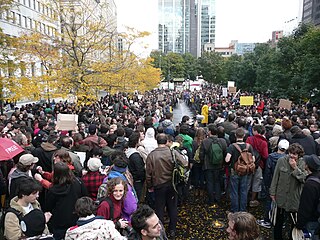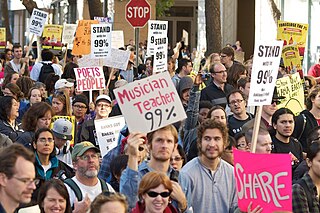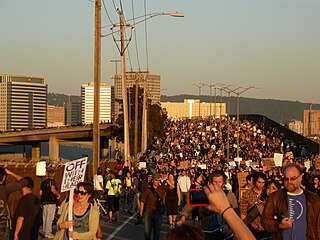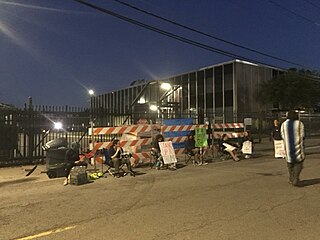
KEZI is a television station in Eugene, Oregon, United States, affiliated with ABC and owned by Allen Media Broadcasting. The station's studios are located on Chad Drive in Eugene, and its transmitter is located on East Prairie Mountain near Horton, Oregon.

KVAL-TV is a television station in Eugene, Oregon, United States, affiliated with CBS. It is owned by Sinclair Broadcast Group, which provides certain services to dual NBC/CW+ affiliate KMTR under a shared services agreement (SSA) with Roberts Media, LLC. Both stations share studios on Blanton Road in Eugene, where KVAL's transmitter is also located. KMTR maintained separate facilities on International Court in Springfield, Oregon, until 2020 when the station relocated to KVAL's building; master control and some internal operations for KMTR were based at the KVAL studios.

Occupy Los Angeles is one of the many occupy movements in the United States, following the original Occupy Wall Street (OWS) protest. Participants of Occupy L.A. first met at Pershing Square on September 23, 2011. Activists came to consensus to occupy public space in solidarity with the growing movement. Occupiers first marched in Los Angeles on September 24, 2011. They next protested a fundraiser being held in Hollywood at the House of Blues for President Obama. Participants met at Pershing Square every subsequent night to plan out the logistics of an occupation set to begin on October 1, 2011. After debating potential locations around Los Angeles, people decided on the lawns around City Hall. Tents first manifested on October 1, 2011 on the grounds of Los Angeles City Hall.

Occupy Portland was a collaboration that began on October 6, 2011 in downtown Portland, Oregon as a protest and demonstration against economic inequality worldwide. It is inspired by the Occupy Wall Street movement that began in New York City on September 17, 2011.

Occupy Seattle was a series of demonstrations in Seattle, Washington, United States in 2011 and 2012, that formed part of the wider Occupy movement taking place in numerous U.S. and world cities at that time. The demonstrations were particularly focused on the city's downtown area including Westlake Park and Seattle City Hall; their stated aim was to oppose wealth inequality, perceived corporate greed, and corruption in the banking and economic systems of the United States.

Occupy Canada was a collective of peaceful protests and demonstrations that were part of the larger Occupy Together movement which first manifested in the financial district of New York City with Occupy Wall Street, and subsequently spread to over 900 cities around the world.

Occupy Toronto was a protest and demonstration that began on October 15, 2011, in Toronto, Ontario, near Bay Street in Downtown Toronto's Financial District and moved to St. James Park. It was a part of the Occupy movement, which protested against economic inequality, corporate greed, and the influence of corporations and lobbyists on government.

Occupy Philadelphia was a collaboration that included nonviolent protests and demonstrations with an aim to overcome economic inequality, corporate greed and the influence of corporations and lobbyists on government. The protest took place at Thomas Paine Plaza, which is adjacent to Philadelphia's City Hall.
Occupy Salem was a collaboration in Salem, Oregon based on the Occupy Wall Street movement which began in New York City on September 17, 2011. Occupy Salem has included peaceful protests and demonstrations.

Occupy Oakland refers to a collaboration and series of demonstrations in Oakland, California, that started in October 2011. As part of the Occupy movement, protestors have staged occupations, most notably at Frank H. Ogawa Plaza in front of Oakland City Hall.

Occupy Houston is a Houston, Texas-based activist group best known for alleged plots against it by the Federal Bureau of Investigation, investigated and called out on in court by Occupy protester Ryan Shapiro, and for being set up by the Austin Police Department. Occupy Houston was a collaboration that has included occupation protests that stand in solidarity with Occupy Wall Street. The planned occupation officially started in Houston, Texas on Thursday October 6, 2011 when protesters returned from JP Morgan Chase Tower to establish an encampment at Hermann Square Plaza. During the JPMorgan Chase demonstration there were not any confrontations with the police and numerous different passerby were reported to have sympathized with the tone of the protesters. That same night the police were reported to have commented on how well behaved the protesters were.

Occupy San Francisco was a collaboration that began with a demonstration event located at Justin Herman Plaza in the Embarcadero and in front of the Federal Reserve building on Market Street in the Financial District in San Francisco, California. It is based on the Occupy Wall Street movement that began in New York City on September 17, 2011 and is one of several "Occupy" protest sites in the San Francisco Bay Area; other sites include Occupy Oakland and Occupy San Jose.

The Occupy movement began in the United States initially with the Occupy Wall Street protests in New York City, but spread to many other cities, both in the United States and worldwide. This list article is an alphabetical, non-chronological summary of Occupy events that have occurred in cities in the United States.
Occupy Salt Lake City was a collaboration that began on October 6, 2011 at Pioneer Park in downtown Salt Lake City, Utah, and has included protests and demonstrations. The protests were based on the Occupy Wall Street movement that started in New York City on September 17, 2011. The Occupy Salt Lake City mission is to stand in solidarity with those also protesting in Wall Street, the United States, and around the world.

The following is a timeline of Occupy Oakland which began on Monday, October 10, 2011, as an occupation of Frank H. Ogawa Plaza located in front of Oakland City Hall in downtown Oakland, and is an ongoing demonstration. It is allied with Occupy Wall Street, which began in New York City on September 17, 2011, and is one of several "Occupy" protest sites in the San Francisco Bay Area. Other sites include Occupy San Francisco and Occupy San Jose.

Occupy Minneapolis (OccupyMN) is a grassroots collaboration that began in October 2011 with a series of demonstrations in Minneapolis, Minnesota. Protesters have staged numerous occupations, most notably of the Hennepin County Government Center plaza.

Occupy ICE is a series of protests, modeled on the Occupy Movement, that emerged in the United States in reaction to the Trump administration family separation policy, with a goal of disrupting operations at several U.S. Immigration and Customs Enforcement (ICE) locations.
Eugene has a long history of community activism, civil unrest, and protest activity. Eugene's cultural status as a place for alternative thought grew along with the University of Oregon in the turbulent 1960s, and its reputation as an outsider's locale grew with the numerous anarchist protests in the late 1990s. According to the Chicago Tribune, the city was called a "cradle to [the] latest generation of anarchist protesters." Occupy Eugene was home to one of the nation's longest-lasting Occupy protests in 2011, with the last protestor leaving the initial Occupy camp on December 27, 2011. The city received national attention during the summer of 2020, after Black Lives Matter protests in response to the murder of George Floyd grew violent.
















